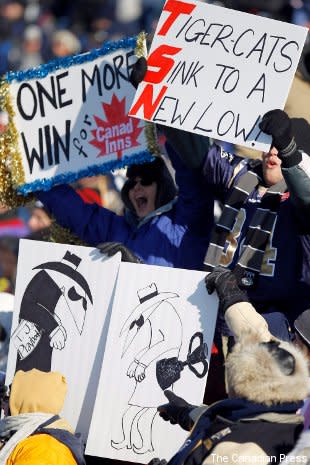Why the Conference Board’s claim Winnipeg can’t support the Jets and Bombers is flawed
Watch out, Winnipeg. Despite an incredible year by the Bombers that saw them go all the way to the Grey Cup game and sell a division-best average of 29,561 tickets per game along the way, and despite remarkable support for the NHL's Jets so far even while they're 10th in the Eastern Conference, the Conference Board of Canada has deemed your city unfit to have two major sports franchises at once. However, the think tank's track record (the same group has previously suggested that the CFL could wind up with 14 teams, albeit down the road, and somehow concluded that Canada could support extra NHL teams in Hamilton and Quebec City, but not Toronto) is problematic, and much of it appears to hinge on rather broad generalizations about the population required to support a franchise in each league rather than actually looking at the level of support for each team. When you look beyond the census data to the way the market supports its teams, Winnipeg seems more than capable of being an excellent home for both the Jets and Bombers.
The Conference Board's reports tend to look at four pillars, including population size, market wealth, corporate presence and a level playing field in the league. All of those pillars certainly matter. However, another important concept that indisputably matters is local passion for the sport in question. This is briefly mentioned in the various Conference Board reports, but it appears to be comparatively glossed over in favour of outlining seemingly-definitive thresholds required for each team.
Interestingly enough, if you read enough of the board's reports, the thresholds themselves appear somewhat dynamic: the May 2011 report on Winnipeg and Quebec City gives the "necessary" thresholds for NHL and CFL support as 800,000 and 250,000 respectively, while November's CFL-specific study doesn't give a particular number (but says that 215,000 is too low, unless you're based in Moncton (pop. 126,000) and can draw from surrounding regions), while this month's NHL-specific study moves that league's threshold to 750,000 (the approximate population of Winnipeg) and appears to peg the needed CFL population at 234,410, while study co-author Mario Lefebvre seems to be telling The Globe and Mail that the benchmarks are 800,000 and 200,000, respectively. That isn't necessarily a problem, as those could be different numbers for particular categorizations the board has developed, but it does demonstrate that you can't necessarily draw a hard-and-fast line on what cities should and should not have franchises based on population data.
The current-day CFL provides plenty of spectacular cases in point as to why local passion may be much more important than raw population data. By the Conference Board's population standards, Toronto and its metropolitan area of 5.7 million people is the most viable area for a CFL franchise, while Regina's 216,000 puts it below the supposed threshold and Winnipeg's approximately 750,000 makes it only viable if there's no NHL in town. Take a look at how the franchises actually do, though. The small-town Saskatchewan Roughriders are unquestionably the economic engine of the CFL, and the Bombers aren't far behind; they not only outdrew every other East Division team (each of which plays in a bigger market) in 2010, but outdrew those teams by over 5,000 fans per game (some of which are seen at right). That's right, too-small Winnipeg currently looks like the CFL's most-successful East Division franchise.
It's not that the Conference Board studies are entirely off-base. They contain some relevant insights, particularly when you read the more-nuanced studies themselves instead of media reports about what they say, and they're quite right that population, market wealth, corporate presence and a level league all matter. However, fan and business support for a team is arguably even more important; just ask the Jets if they'd rather be in a 750,000-person town with relatively few corporate headquarters that supports them the way Winnipeg does, or a town of over 5 million people with tons of big corporations that supports them the way Atlanta did.
There's a reason that Saskatchewan and Winnipeg are currently more successful CFL markets than Toronto, and it's not their greater populations. Support isn't purely additive, either, as many people attend both CFL and NHL games; it's worth adding that the Bombers' leadership wasn't particularly worried about the return of the Jets last spring, and their impressive fall ticket sales would seem to suggest they were right. Support isn't necessarily easy to quantify, although information such as ticket and merchandising sales is a step in the right direction, but it is a vital factor in a franchise's success. It may not be one of the Conference Board's vaunted four pillars, but it suggests that both Winnipeg franchises will be just fine for the foreseeable future.

 Yahoo Sports
Yahoo Sports 



